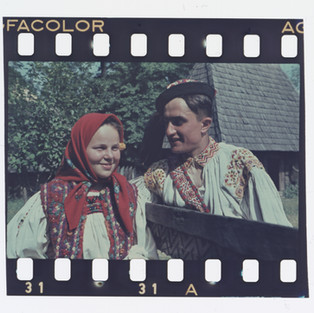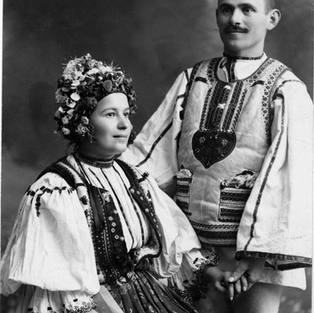The Dragobete Meets Valentine's Day / Geographies of Tradition
- RCI USA
- Feb 24, 2021
- 8 min read
Updated: Feb 25, 2021
Two customs, one meaning: the celebration of love

The celebration of Dragobete, like any socio-cultural event, has a history behind it. Long ago, in certain ethnographic or geographical areas of Romania, Dragobete was celebrated on the 24th of February, in others it was celebrated on the 1st of March. For the Romanian peasant, it represented a day for a new beginning. It was as if the wheel of time, with the year before, had grown old, had begun to creak, suggesting that it might stop in its tracks and, suddenly, at once, the temporal cycle began again, with all the joy and momentum of a new beginning: the warmth of spring brought the entirety of nature back to life, and the sun’s rays inflamed people's hearts, giving them back the joy of living. Of being together. Today we would give this joy of meeting the other with a more precise, more technical, but also colder name: socialization.
The (pre-) history of a holiday in its beliefs and customs

From the crack of dawn on the day of Dragobete, boys and maidens, young men and women, after waking up, would wash their faces, comb their hair. In other words, they would groom themselves. Then, if the weather seemed promising, they would gather in groups to gather freshly sprung snowdrops from the woods, or to gather dry wood for fire. But they did not head off in a disorderly, arbitrary fashion: first, girls or young women would head off, after which boys or men would follow suit. If the weather happened to be gloomy, then girls would gather in the houses of their friends or relatives. There, neighboring boys would pay them a visit. The purpose was to have a good time. They chatted amongst themselves and joked around. For them, this is what it meant to “make Dragobete”. They believed that if they exchanged jokes and were happy on that particular day, then they would fall in love that very year, and the person dear to their heart would respond with the same fiery feelings. Eligible young men and women “accompanied” each other and “got married” in play: they embraced and kissed, pledging their sincerity and faithfulness to each other.


In the archaic collective mentality, dominant in the communities of yesteryear, a reverse scenario also existed: if it so happened that a girl did not fall in love for a whole year or if her love was not reciprocated, she interpreted this failure in a magical sense: it meant that another girl or woman had cast “abomination” charms upon her, so that boys or men would not be interested in her.
In many Romanian regions, the peasants “held Dragobete”, meaning they were very careful not to work: they did not plow the fields, they did not sew, they did not wash, in order to be “protected from disease”, blows or scratches, and so that the harvest of that year might be rich. It was, however, considered permissible to clean the house. Certain ancestral beliefs reference man’s impulse to read, to decode signs within nature, in order to gain insight into the future. For instance, generations of Romanians believed that if it rained on Dragobete, this signified a long and beautiful spring ahead, and that whoever heard the hoopoe chirping on that day would prove to be a diligent man or woman all year round.
This being said, Dragobete was not celebrated on February 24th in every Romanian region. In some places, people considered that it fell on March 1st. For this reason, it was called “Dragobete, Head of Spring”. With it, the new agricultural year began. It was said that a bear named Old Martin (a character in Romanian mythology) wandered out of his den around this time, after having hibernated all winter. It was also said that on the day of Dragobete, birds mate and make their nests.
Dragobete was, therefore, perceived as a celebration of spring, of life, of a new beginning. Maidens would collect water from the snow. With this water, they would wash themselves year-round, in hopes of becoming beautiful and loving as a result. A poetic version of this ritualistic custom has been preserved in collective Romanian memory: unmarried girls “made Dragobete love”: they collected dew from wild strawberries and washed their faces with it, in order “to be handsome and seen when going dancing”. These gestures were accompanied by a short incantation:

Wild strawberry flower,
Now that the month of March is underway,
Let me be dear to those I encounter,
You keep curses away.
In days of yore, girls also made sure to pick spring flowers on Dragobete, which they used as needed when casting love spells. Violets were selected and thrown into running water on Sânziene (or Midsummer, on June 24th). In common lore, the phrase “Dragobete kisses the girls" was often heard as this day neared.

A practice that was common until recently may clarify this saying for us. In some places, at noon, the girls would come running towards the village. A boy would follow the girl he loved, she would let herself be caught and kissed in front of everyone.
The kiss was equivalent to a symbolic engagement that lasted around a year. Interestingly, many of these “engagements” did later evolve into lawful weddings.
In conclusion, when you refer to “The Feast of Dragobete”, you are referring to love. Secondary questions soon arise: how can one encourage this divine feeling? And if you have managed to provoke such sentiments in someone else, what should be done to maintain them, as Vestals once maintained the sacred fire of the family home?
Mythical Dragobete
In certain Romanian legends, Dragobete is the son of Baba Dochia. If Baba Dochia is the embodiment of evil forces (plotting her daughter-in-law’s downfall), then Dragobete is the exponent of the opposite, positive principle of renewal. This myth, noted Romanian scholar Mircea Eliade, is a sacred story spent in the past. In the mist of time. In illo tempore. The deeds committed by the mythical hero are exemplary. Ethnologists have competed in expressing all sorts of hypotheses and theories surrounding this mythical character. Some have suggested that Dragobete is the Romanian equivalent of the divine messengers Cupid/Eros. He is “the bearer of love and happiness in the Romanian lands”. According to others, he is, in fact, a god of love hailing the era of the Dacians, who are the ancestors of Romanians.
Valentine's Day, between myth and reality. Some aspects of cultural archaeology

We leave the spiritual realm of Europe and head for the American continent. Americans celebrate Valentine's Day every year on February 14th. At dusk, they dine by warm, intimate candlelight, exchange gifts, and send each other messages inspired by their feelings of love.
The holiday is linked to the name of Saint Valentine by way of a complex history, unlike the Romanian Dragobete. Let us travel back in time, then, and stop in the third century, in Rome – the prestigious and splendid capital of the famous and haloed empire. It is said that a priest named Valentine secretly officiated a marriage between two lovers, although Emperor Claudius II had given an order forbidding this ritualistic Christian custom. The general conception was that an unmarried man, not being tied down by a family, would be an independent soldier, much better prepared for the imperial army. Ultimately, Valentine the priest was sentenced to death and executed for his reckless act of disobedience.
According to another version of this story, now lost in the mist of time, Bishop Valentine of Terni, beheaded during the reign of the same emperor, Claudius II, during the persecutions against Christians in 270 A.D., may be the inspiration for The Feast of St. Valentine.
Finally, the third version of the legend tells us that Valentine, a Roman prisoner, was condemned for trying to save Christians from imprisonment and death. Before he was martyred, he sent a love letter from prison to a girl he had fallen in love with. The girl was the daughter of a prison guard named Asterius. The saint-to-be concluded his letter by signing: “from your Valentine”. This legend may provide the origin of the custom of sending letters or postcards to one’s beloved on Valentine's Day, hence in English these passionate letters are called “Valentines”.
This custom of epistolary exchange between lovers has itself a history. It seems that the oldest letter or card of this kind, sent on Valentine's Day in 1415, was authored by the Duke of Orleans: it is a poem written especially for his wife.
Although it is believed that the custom of sending such letters dates back to around 1700 in the United States, the phenomenon truly gained momentum in 1840. In that year, Esther A. Howland, an artist from Massachusetts, dubbed “the first career woman in New England”, created romantic cards from handmade paper, decorated with lace, colorful designs, and ribbons. Since then, she has been nicknamed “Valentine’s Mother”, or rather the mother of Valentine's Day. From then on, those extremely appealing greeting cards began to be commercialized extensively, and they sold much better than ordinary lithographed greeting cards.
One might ask why Valentine's Day is celebrated in American communities on February 14th. Why on this day of all days? One possible explanation is that the Christian Church might have decided that Valentine's Day should be celebrated on February 14th in order to counter a pagan celebration of fertility: Lupercalia (which took place annually between February 13th and 15th). It was dedicated to the god Faunus, revered by the Romans. To ensure their fertility, the Romans sacrificed animals and the bachelors chose their future wives with this occasion.
In the fifth century, The Feast of Saint Valentine was made official in Christian communities: Pope Gelasius declared February 14th The Feast Day of Saint Valentine and declared Lupercalia, the Roman feast of fertility, pagan. In The Middle Ages, Valentine became a common name in France and England.
But when did Valentine's Day become the day of universal love? There is no clear answer. Perhaps in 1382, the year in which the English poet Geoffrey Chaucer wrote the poem Parlement of Foules, dedicated to the married couple King Richard II and Anna of Bohemia.
Dragobete/Valentine 's Day. Two names, one meaning: the celebration of love
Many of these beliefs and customs have already become history. Romanian women no longer wash themselves with dew collected from the flowers of wild strawberry bushes. After all, it would be a silly thing to do in a consumer society that offers them so many beauty products. They no longer whisper love spells, but do their best to remain beautiful, to be loved and to gain the love of their chosen partner. The need to manifest one’s love, to spend wonderful moments in the company of one’s loved one remains a common feature of Americans, Romanians, and of human beings in general.

Whether we like it or not, we, Romanians or Americans, live in consumer societies. A consumer society has its advantages, but it also has disadvantages, like any society. Many American publications have pointed out that Valentine's Day is a “brand celebration”. The temptation to brand everything, including ourselves, is considerable. If one analyzes the behavior of American and Romanian lovers, one is bound to discover many similarities between them. It would be inaccurate to blame them all on our tedious consumerist behavior. On Valentine's Day, young and old people alike, Romanians and Americans exchange gifts (jewelry, heart-shaped sweets), romantic dinners replete with flowers and candles, champagne and chocolate in the name of the love that warms their souls. They send each other greeting cards, postcards (“Valentines”) or simple text messages expressing their feeing’s. Time can erase the form in which we manifest our love for each other. But only one rival can face and defeat time: the love between us.
Text by Ciprian Voicilă, sociologist at the National Museum of Romanian Peasant.
English translation by Andreea Scridon.
>>>>>
The launch of "Geographies of Tradition," our newest online series that looks at mirroring Romanian and American celebrations, is placed under the aegis of love, invoked on both sides of the Atlantic by two popular feasts. The program’s opening episode, created in partnership with the National Museum of Romanian Peasant, examines the origins, meaning and parallels of the customs of the Dragobete and Valentine’s Day, both infusing excitement and desire in the dark, cold days of February.
Written and presented by Ciprian Voicilă.
Video editing by Dragoș Popa.
English translation by Andreea Scridon.
Photo Gallery:
Photos from the Ethnological Archive of the National Museum of the Romanian Peasant in Bucharest:


























